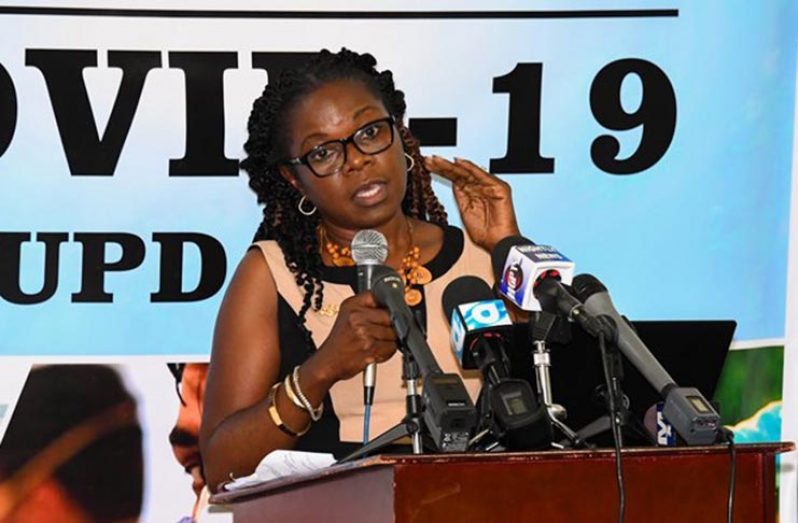…authorities say 50% of the total cases have recovered, 10% of all cases were children
GUYANA has recorded five new cases of the Novel Coronavirus (COVID-19), a clear indication of the continued rise in cases.
Deputy Chief Medical Officer (DCMO), Dr. Karen Boyle, said health authorities discovered the new cases after testing 39 persons, on Wednesday.
Some 3,418 persons have been tested for the disease, with 3,105 being negative and 313 testing positive. Of the positive cases, 156 persons have recovered and 19 persons have died, but there are 139 active cases of disease, which are being monitored by local authorities. Five of the active cases are being treated in the COVID-19 Intensive Care Unit (ICU).
The consistent rise in cases has been worrying for authorities, who continue to call on persons to be responsible in their daily conduct. On many occasions, authorities have said the rise in cases is due mainly to the callous behaviour of some sections of the population. Those persons were accused of flouting the control measures and failing to adhere to advisories.
Dr. Boyle said it is clear that persons need to be more responsible, and in justifying her call, she referred to a graph which showed the cumulative COVID-19 cases reported in Regions One (Barima-Waini), Four (Demerara-Mahaica) and Seven (Cuyuni-Mazaruni), from March to July.
During the four-month period, Region Four recorded a steady climb in cases from March-May, with successful flattening of the curve in June, when the region recorded just four cases, and then a steady climb in July.
in Region One, the first case was reported in April and it remained that way until May 19, 2020. Thereafter, there was a relatively slow rise, until June 15, when 11 cases were recorded. Statistics showed that there was a consistent rise after that date, and from then to July 12, the region has recorded 80 cases.
Region Seven recorded its first case on May 13, and there was a continued rise from then on. To date, the region has recorded 44 cases.
“I have chosen to make this comparison to emphasise the challenge of contact tracing in the hinterland where often there are no street names or lot numbers. Finding contacts to have them quarantined becomes a particular challenge and hence the exponential increase in cases in these regions,” Dr. Boyle lamented.
In Regions One and Seven combined, since June 12, there have been 110 cases, six cases less than the total number of cases in Region Four.
As it is now, Region One has the highest per capita infection rate, followed by Region Seven and Region Four.
Despite the glaring challenges, Dr. Boyle said authorities are doing all they can to reduce the spread of the disease in hinterland regions.
Strategies towards this include limited travel in and out of these regions; maintaining the curfew; closure of schools and workplaces; and the stipulation for citizens to maintain social distancing and wear face masks.
“Additionally, we need to heighten vigilance concerning undocumented migrants from Brazil and Venezuela who may not have been quarantined. Please note that any such persons need to be reported to the relevant authorities,” said Dr. Boyle.
Authorities are banking on those measures to reduce the spread of the disease, which does not infect a specific group, but leaves everyone vulnerable.
For example, a number children have been infected with the disease. And, according to existing statistics from March 11 to July 12, 2020, in the 0-five age group, there were 11 children representing 3.9 per cent of all total cases have had the disease; in the six-10 age group, eight persons, representing 2.8 per cent; and in the 11-15 age group, 12 children representing 4.2 per cent; a total of 31 children representing 10 per cent of all cases.
“Parents, we need to remind you to do your part and protect your children; make sure when you are sending them to the market that they have all the required things: masks, sanitiser; encourage your children to comply with the guidelines so that they are not infected,” Dr. Boyle advised.
She lamented that the highest rate of infection is in the 21-60 age group, representing 70 per cent of all infections. This is the very age group most likely to be out and about and therefore at increased risk for exposure to COVID-19, said the DCMO.
COVID-19 remains a serious issue not just here in Guyana, but globally as well, and according to global statistics, there are 12.9 million cases of COVID-19, with over 570,000 deaths. And, with no approved treatment or cure, there is no assurance that persons will survive after contracting the disease. In the absence of approved medications, governments and authorities across the world have employed a number of preventive measures to contain the spread of the disease.




.png)









